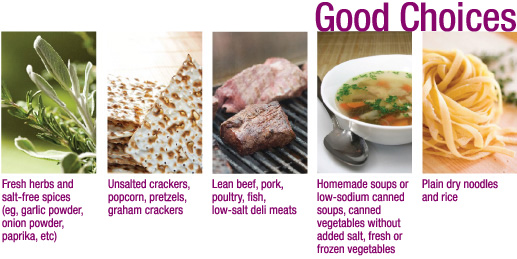(Submitted by Health Solutions Inc.)
Facts About Sodium
Sodium and the renal diet
If you are in the early stages of chronic kidney disease (CKD), your doctor and dietician will monitor your blood pressure. Controlling blood pressure is important in managing kidney disease, especially in the early stages. Sodium restriction is recommended if blood pressure is high or if you are retaining fluid. Low sodium diets range from 1,000 to 4,000 mg based on individual requirements. The average range for most low sodium diets is 2,000 to 3,000 mg a day. If you have other medical conditions, such as heart or liver disease, you may need to restrict sodium more.
If you are at stage 5 CKD, also know as end stage renal disease (ESRD), and require dialysis you will be asked to follow a low sodium diet. The diet will help with blood pressure control. It will also help you control thirst and fluid intake. Controlling sodium intake will help avoid cramping and blood pressure drops during dialysis.
What can you do to cut back on sodium?
One of the most important things you can do is talk with your medical team. Your medical team can help you determine the sodium content of your favourite foods and recommend ways to reduce your sodium intake. At first, you may miss the taste of salt. Gradually, however, you will start to taste more of the natural flavours in foods. You will learn how to season food with lower sodium ingredients, and how much sodium can be safely included in your diet. You may also be encouraged to keep a food diary that lists what you’ve eaten each day. This diary can be used to determine if changes need to be made to your diet, especially if you experience swelling or an increase in blood pressure.
Many patients are surprised to learn certain foods and beverages have so much “hidden” sodium. Hidden sodium is sodium that is present in food, but is not noticed because the food does not taste salty.
Tips for managing sodium intake
• Know how much sodium you are allowed to have each day.
• Keep an accurate food diary
• Read food labels
• Limit the amount of processed and canned foods in your diet
• Watch your beverage intake
• Try substituting fresh herbs and other spices to flavour foods
• Report any changes to your weight or any swelling to your medical team
• Be cautious when eating in restaurants and request condiments and salad dressings on the side
Healthy Low Sodium Foods
• 1/2 cup Red bell peppers = 1 mg sodium
• 1/2 cup of green cabbage = 6 mg sodium
• 1/2 cup boiled cauliflower = 9 mg sodium
• 1 garlic clove = 1 mg sodium
• 1/2 cup of onion = 3 mg sodium
• 1 medium apple with skin = 0 sodium
• 1/2 cup of Cherries = 0 mg sodium
• 1/2 cup of Red Grapes = 1 mg sodium
• 2 egg whites = 110 mg sodium
• 3oz wild salmon = 50 mg sodium
• 1 Tbsp olive oil = less than 1 mg sodium
• I cup of breadfruit = 0 mg of sodium
High Sodium Foods
• Table salt, baking soda, and baking powder
• Bouillon cubes, Powdered Broths, Soups, and Gravies
• Soy Sauce, Other Sauces, and Salad Dressings
• Salami, Bacon, and Cured Meats
• Cheese
• Snack Foods (Pretzels, Cheese Puffs, and Pop- corn)
• Pickled Foods
• Seasoning with MSG (Monosodium glutamate, a common food additive)
What kinds of spices and herbs should I use instead of salt to add flavour?
• Allspice – Use with beef, fish, beets, cabbage, carrots, peas, fruit.
• Basil & Bay leaf – Use with beef, pork, most vegetables.
• Cardamom – Use with fruit and in baked goods.
• Curry – Use with beef, chicken, pork, fish, green beans, carrots and in marinades.
• Dill – Use with beef, chicken, green beans, cabbage, carrots, peas and in dips.
• Ginger – Use with beef, chicken, pork, green beans, cauliflower and eggplant.
• Rosemary – Use with chicken, pork, cauliflower, peas and in marinades.
• Thyme – Use with beef, chicken, pork, fish, green beans, beets and carrots.
• Sage – Use with chicken, pork, eggplant and in dressing.
• Tarragon – Use with fish, beets, cabbage, cauliflower and in marinades






